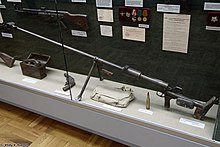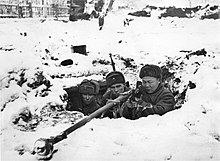PTRD-41
| PTRD-41 | |
|---|---|
 | |
| Type | Anti-tank rifle |
| Place of origin | Soviet Union |
| Service history | |
| In service | 1941–1960s (USSR) |
| Used by | See Users |
| Wars | World War II Korean War Chinese Civil War Vietnam War[1] Syrian Civil War Russo-Ukrainian War[2][3][4][5] |
| Production history | |
| Designer | Vasily Degtyaryov |
| Designed | 1941 |
| Manufacturer | Degtyaryov plant |
| Produced | 1941–1945 |
| No. built | ~450,000[6] |
| Specifications | |
| Mass | 17.3 kg (38.1 lbs) |
| Length | 2,020 mm (79.5 in) |
| Barrel length | 1,350 mm (53 in) |
| Crew | 2 |
| Cartridge | 14.5×114mm (B-32, BS-41[7]) |
| Action | Bolt-action |
| Rate of fire | Manual |
| Muzzle velocity | 1,012 m/s (3,320 ft/s) |
| Effective firing range | 300 m (980 ft) (on personnel targets, dispersion of bullets at 300 m (980 ft) is 0.36 m (1 ft 2 in)[7]) |
| Maximum firing range | 1,000 m (3,300 ft)[7] (mainly with scope) |
| Feed system | Single-shot |
| Sights | Front post, rear notch |
The PTRD-41 (Russian: Противотанковое самозарядное ружьё образца 1941 года системы Дегтярёв, romanized: Protivotankovoye samozaryadnoye ruzhyo obraztsa 1941 goda sistemy Degtyaryova, lit. 'Anti-tank self-loading gun pattern 1941, Degtyaryov system') is an anti-tank rifle that was produced and used from 1941 by the Soviet Red Army during World War II. It is a single-shot weapon which fires the 14.5×114 mm round, which was able to penetrate German tanks such as the Panzer III and early models of the Panzer IV. Although unable to penetrate the frontal armor of late-war German tanks, it could penetrate their thinner side and top armor at close ranges as well as thinly armored self-propelled guns and half-tracks.
History
[edit]
In 1939, during soviet invasion of Poland the USSR captured several hundred Polish kb ppanc wz. 35 anti-tank rifles, which had proved effective against German tanks during the September Campaign. A Russian engineer Vasily Degtyaryov copied its lock[8][9] and several features[clarification needed] of the German Panzerbüchse 38 when hasty construction of an anti-tank rifle was ordered in July 1941.[citation needed]
The PTRD and the similar but semi-automatic PTRS-41 were the only individual anti-tank weapons available to the Red Army in numbers upon the outbreak of the war with Germany. The 14.5 mm armor-piercing bullet had a muzzle velocity of 1,012 m/s (3,320 ft/s). The 64 g (2.3 oz) bullet had a 39 g (1.4 oz) steel core and could penetrate around 30 mm (1.2 in) of armor at 500 m (1,600 ft), and 40 mm (1.6 in) of armor at 100 m (330 ft).[10] During the initial invasion, and indeed throughout the war, most German tanks had side armor thinner than 40 mm (1.6 in) (Panzer I and Panzer II: 13–20 mm (0.51–0.79 in), Panzer III and Panzer IV series: 30 mm (1.2 in), Panzer V Panther (combat debut mid-1943): 40–50 mm (1.6–2.0 in)).
Guns captured by the Germans were given the designation 14.5 mm PzB 783(r).[11] After World War II the PTRD was also used extensively by North Korean and Chinese armed forces in the Korean War. During this war, William Brophy, a US Army Ordnance officer, mounted a .50 BMG (12.7 mm) barrel to a captured PTRD to examine the effectiveness of long-range shooting. Furthermore, the US also captured a number of PTRDs in the Vietnam War. The weapon proved effective out to 1,800 m (5,900 ft).[12]
Users
[edit]This section needs additional citations for verification. (March 2019) |
Current
[edit]

 Donetsk People's Republic: Used by militiamen in 2014.[13]
Donetsk People's Republic: Used by militiamen in 2014.[13] Russia: Limited use in the Syrian civil war[14]
Russia: Limited use in the Syrian civil war[14] Ukraine: Limited use in the war in Donbas[14]
Ukraine: Limited use in the war in Donbas[14]
Former
[edit] Bulgaria: Equipped with 300 items (both PTRD & PTRS) by Soviet Union between 1944 and 1945, seen in combat operations.
Bulgaria: Equipped with 300 items (both PTRD & PTRS) by Soviet Union between 1944 and 1945, seen in combat operations. China: Used in Chinese Civil War, later by People's Volunteer Army during Korean War.
China: Used in Chinese Civil War, later by People's Volunteer Army during Korean War. Czechoslovakia: Used by 1st Czechoslovak Army Corps in the USSR.
Czechoslovakia: Used by 1st Czechoslovak Army Corps in the USSR. Nazi Germany: Captured and used by Wehrmacht under the title Panzerbüchse 783(r).[11]
Nazi Germany: Captured and used by Wehrmacht under the title Panzerbüchse 783(r).[11] North Korea: Equipped by the USSR, saw extensive combat in Korean War against M24 light tanks.[15]
North Korea: Equipped by the USSR, saw extensive combat in Korean War against M24 light tanks.[15] Poland: Used by 1st Tadeusz Kościuszko Infantry Division in 1943 then by other Polish divisions.
Poland: Used by 1st Tadeusz Kościuszko Infantry Division in 1943 then by other Polish divisions. North Vietnam: In stockpile, used by Viet Cong in Vietnam War.[1]
North Vietnam: In stockpile, used by Viet Cong in Vietnam War.[1] Soviet Union: Largely used in Eastern Front by the Red Army.[15]
Soviet Union: Largely used in Eastern Front by the Red Army.[15]
See also
[edit]References
[edit]- ^ a b "WWII German weapons during the Vietnam War". wordpress.com. 10 July 2015. Retrieved 8 December 2017./
- ^ "- YouTube". YouTube.
- ^ "PTRD in Ukraine". 5 October 2014.
- ^ "PTRS-41 and PTRD-41 rifles in action at the conflict in Ukraine". 13 October 2014.
- ^ Sneider, Noah (24 July 2014). "Huddling with Ukrainian Rebels in a Bunker on the Front Lines". The New Republic.
- ^ Dunn, Walter S. Jr. (1995). The Soviet economy and the Red Army, 1930-1945 (1. publ. ed.). Westport, Conn.: Greenwood. p. 103. ISBN 9780275948931.
- ^ a b c Manual on Small Arms (NSD-42) Military Publishing House Moscow 1942
- ^ "Karabin przeciwpancerny wz. 35". 10 June 2020.
- ^ "Karabin przeciwpancerny wz. 35 "Ur"". YouTube.
- ^ "Page 6: Tank Rifles", Panzerfaust: WW II German Infantry Anti-Tank Weapons, 1998, archived from the original on 27 October 2009
- ^ a b Chamberlain, Peter; Gander, Terry (1974). Anti-tank weapons. New York: Arco Pub. Co. p. 57. ISBN 0668036079. OCLC 1299755.
- ^ "Hard Target Interdiction" (PDF). www.remingtonmilitary.com/. Remington Arms. 2005. Archived from the original (PDF) on 20 March 2006. Retrieved 13 December 2008.
- ^ Jenzen-Jones, N.R.; Ferguson, Jonathan (2014). Raising Red Flags: An Examination of Arms & Munitions in the Ongoing Conflict in Ukraine (PDF). Armament Research Services Pty. Ltd. p. 43. ISBN 9780992462437.
- ^ a b "The Sniper Weapon Systems of Russian Forces in Syria". The Hoplite. Armament Research Services (ARES). 6 August 2016. Retrieved 25 April 2024.
- ^ a b "Warfare History Network » WWII Weapons: The PTRS and PTRD Russian Anti-Tank Rifles". warfarehistorynetwork.com. Archived from the original on 14 January 2017.
- Koll, Christian (2009). Soviet Cannon - A Comprehensive Study of Soviet Arms and Ammunition in Calibres 12.7 mm to 57 mm. Austria: Koll. p. 91. ISBN 978-3-200-01445-9.
External links
[edit]
